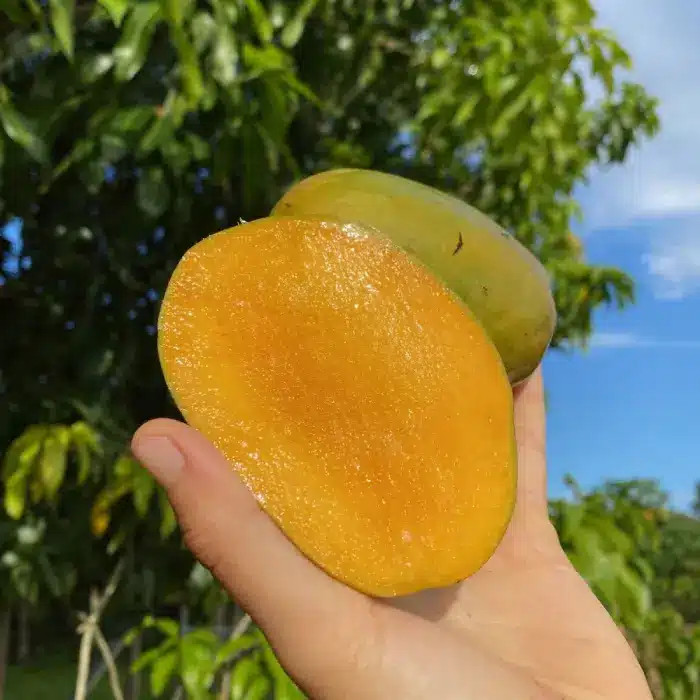Hey, if you're liking what you see thus far, how about leaving us a testimonial? 
Hey, if you're liking what you see thus far, how about leaving us a testimonial? 
 Julie mangoes were introduced to the United States in the 1910s by nurseryman Lawrence Zill . The Julie mango is a beloved mango variety originating from the West Indies, particularly Trinidad and Tobago. It is renowned for its rich, sweet flavor and vibrant tropical aroma. The fruit is small to medium-sized, typically weighing between 8 to 12 ounces, and has a distinctive oblong shape with a slight curve. The skin of the Julie mango is a beautiful yellow-orange with a red blush when ripe, and its flesh is deep orange, fiberless, and incredibly juicy. The flavor is often described as a perfect balance of sweetness and acidity, with hints of citrus and peach.
The Julie mango tree is a dwarf variety, making it an excellent choice for home gardeners with limited space. Despite its small size, the tree is highly productive and can yield abundant crops under the right conditions. It is also known for its adaptability to various climates, thriving in both tropical and subtropical regions. However, the Julie mango tree is somewhat susceptible to fungal diseases like Anthracnose , so proper care and maintenance are essential for optimal growth and fruit production.
Historically, the Julie mango has been a staple in the Caribbean for generations. It is believed to have been introduced to Florida in the mid-20th century, where it gained popularity among mango enthusiasts. The variety is often praised for its exceptional flavor and compact growth habit, making it a favorite for both fresh consumption and culinary uses. Its rich history and cultural significance in the Caribbean have cemented its status as one of the most cherished mango varieties in the world.
Julie mangoes were introduced to the United States in the 1910s by nurseryman Lawrence Zill . The Julie mango is a beloved mango variety originating from the West Indies, particularly Trinidad and Tobago. It is renowned for its rich, sweet flavor and vibrant tropical aroma. The fruit is small to medium-sized, typically weighing between 8 to 12 ounces, and has a distinctive oblong shape with a slight curve. The skin of the Julie mango is a beautiful yellow-orange with a red blush when ripe, and its flesh is deep orange, fiberless, and incredibly juicy. The flavor is often described as a perfect balance of sweetness and acidity, with hints of citrus and peach.
The Julie mango tree is a dwarf variety, making it an excellent choice for home gardeners with limited space. Despite its small size, the tree is highly productive and can yield abundant crops under the right conditions. It is also known for its adaptability to various climates, thriving in both tropical and subtropical regions. However, the Julie mango tree is somewhat susceptible to fungal diseases like Anthracnose , so proper care and maintenance are essential for optimal growth and fruit production.
Historically, the Julie mango has been a staple in the Caribbean for generations. It is believed to have been introduced to Florida in the mid-20th century, where it gained popularity among mango enthusiasts. The variety is often praised for its exceptional flavor and compact growth habit, making it a favorite for both fresh consumption and culinary uses. Its rich history and cultural significance in the Caribbean have cemented its status as one of the most cherished mango varieties in the world.





